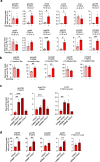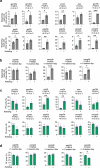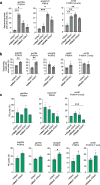Enhancing CRISPR prime editing by reducing misfolded pegRNA interactions
- PMID: 38847802
- PMCID: PMC11161173
- DOI: 10.7554/eLife.90948
Enhancing CRISPR prime editing by reducing misfolded pegRNA interactions
Abstract
CRISPR prime editing (PE) requires a Cas9 nickase-reverse transcriptase fusion protein (known as PE2) and a prime editing guide RNA (pegRNA), an extended version of a standard guide RNA (gRNA) that both specifies the intended target genomic sequence and encodes the desired genetic edit. Here, we show that sequence complementarity between the 5' and the 3' regions of a pegRNA can negatively impact its ability to complex with Cas9, thereby potentially reducing PE efficiency. We demonstrate this limitation can be overcome by a simple pegRNA refolding procedure, which improved ribonucleoprotein-mediated PE efficiencies in zebrafish embryos by up to nearly 25-fold. Further gains in PE efficiencies of as much as sixfold could also be achieved by introducing point mutations designed to disrupt internal interactions within the pegRNA. Our work defines simple strategies that can be implemented to improve the efficiency of PE.
Keywords: RNA structure; gene editing; genetics; genomics; protein delivery; zebrafish.
© 2023, Zhang et al.
Conflict of interest statement
WZ, JM, HL, CT, JY No competing interests declared, KP has a financial interest in SeQure Dx, Inc. KP's interests and relationships have been disclosed to Massachusetts General Hospital and Mass General Brigham in accordance with their conflict of interest policies, JJ has, or had during the course of this research, financial interests in several companies developing gene editing technology: Beam Therapeutics, Blink Therapeutics, Chroma Medicine, Editas Medicine, EpiLogic Therapeutics, Excelsior Genomics, Hera Biolabs, Monitor Biotechnologies, Nvelop Therapeutics (f/k/a ETx, Inc), Pairwise Plants, Poseida Therapeutics, SeQure Dx, Inc, and Verve Therapeutics. JKJ's interests were reviewed and are managed by Massachusetts General Hospital and Mass General Brigham in accordance with their conflict of interest policies. JKJ is a co-inventor on various patents and patent applications that describe gene editing and epigenetic editing technologies
Figures






Update of
-
Enhancing CRISPR prime editing by reducing misfolded pegRNA interactions.bioRxiv [Preprint]. 2023 Aug 15:2023.08.14.553324. doi: 10.1101/2023.08.14.553324. bioRxiv. 2023. Update in: Elife. 2024 Jun 07;12:RP90948. doi: 10.7554/eLife.90948. PMID: 37645936 Free PMC article. Updated. Preprint.
Similar articles
-
Enhancing CRISPR prime editing by reducing misfolded pegRNA interactions.bioRxiv [Preprint]. 2023 Aug 15:2023.08.14.553324. doi: 10.1101/2023.08.14.553324. bioRxiv. 2023. Update in: Elife. 2024 Jun 07;12:RP90948. doi: 10.7554/eLife.90948. PMID: 37645936 Free PMC article. Updated. Preprint.
-
Highly efficient generation of isogenic pluripotent stem cell models using prime editing.Elife. 2022 Sep 7;11:e79208. doi: 10.7554/eLife.79208. Elife. 2022. PMID: 36069759 Free PMC article.
-
A truncated reverse transcriptase enhances prime editing by split AAV vectors.Mol Ther. 2022 Sep 7;30(9):2942-2951. doi: 10.1016/j.ymthe.2022.07.001. Epub 2022 Jul 8. Mol Ther. 2022. PMID: 35808824 Free PMC article.
-
Genome editing using CRISPR/Cas9-based knock-in approaches in zebrafish.Methods. 2017 May 15;121-122:77-85. doi: 10.1016/j.ymeth.2017.03.005. Epub 2017 Mar 12. Methods. 2017. PMID: 28300641 Review.
-
Prime editing: a search and replace tool with versatile base changes.Yi Chuan. 2022 Nov 20;44(11):993-1008. doi: 10.16288/j.yczz.22-156. Yi Chuan. 2022. PMID: 36384993 Review.
Cited by
-
Click editing enables programmable genome writing using DNA polymerases and HUH endonucleases.Nat Biotechnol. 2025 Jun;43(6):923-935. doi: 10.1038/s41587-024-02324-x. Epub 2024 Jul 22. Nat Biotechnol. 2025. PMID: 39039307 Free PMC article.
-
CRISPR/Cas9 Landscape: Current State and Future Perspectives.Int J Mol Sci. 2023 Nov 8;24(22):16077. doi: 10.3390/ijms242216077. Int J Mol Sci. 2023. PMID: 38003266 Free PMC article. Review.
-
Chemical engineering of CRISPR-Cas systems for therapeutic application.Nat Rev Drug Discov. 2025 Mar;24(3):209-230. doi: 10.1038/s41573-024-01086-0. Epub 2024 Dec 17. Nat Rev Drug Discov. 2025. PMID: 39690326 Review.
-
Optimized Ribonucleoprotein Complexes Enhance Prime Editing Efficiency in Zebrafish.Animals (Basel). 2025 Aug 6;15(15):2295. doi: 10.3390/ani15152295. Animals (Basel). 2025. PMID: 40805085 Free PMC article.
-
Successful Correction by Prime Editing of a Mutation in the RYR1 Gene Responsible for a Myopathy.Cells. 2023 Dec 22;13(1):31. doi: 10.3390/cells13010031. Cells. 2023. PMID: 38201236 Free PMC article.
References
MeSH terms
Substances
Grants and funding
LinkOut - more resources
Full Text Sources
Other Literature Sources
Research Materials

